Cosmetic tattooing is one of the fastest-growing fields in the beauty industry. From creating fuller-looking eyebrows and defined lips, camouflaging scars or restoring areolas, cosmetic tattooists are not just beauty professionals, they're confidence restorers and transformation artists.
If you've ever thought about becoming a cosmetic tattooist in Australia, I’m here to guide you and break down the steps, myths, and realities so you can approach the journey with confidence, strategy, and creativity.

Finding Your Passion: Why Do You Want to Be a Cosmetic Tattooist?
Every fulfilling career starts with purpose. Before you begin researching courses or studios, take a moment to understand what draws you to cosmetic tattooing.
Ask yourself:
- Are you fascinated by beauty and aesthetics?
- Do you enjoy working one-on-one with clients to help them feel their best?
- Are you artistically inclined, with a steady hand and keen eye for symmetry?
- Are you motivated by helping others restore a sense of normalcy after illness or trauma?
Understanding your “why” helps you stay grounded during the learning curve and remain committed through the inevitable ups and downs of the profession. Passion fuels persistence, especially when you’re building skills, clientele, and credibility.
Getting Your Foot in the Door: Where Do You Start?
Starting out can be the most intimidating part. The cosmetic tattooing industry has unique challenges, particularly because it's a highly regulated skin penetration procedure. Your first step should be to understand local council and state regulations. Most states require:
- Infection control certification (such as HLTINF005 – Maintain infection prevention for skin penetration treatments or SHBBINF002- Maintain Infection Control)
- A council-approved premises license (for those planning to operate independently)
- Health department registration
From there, your entry into the field may begin as:
- An assistant in a cosmetic tattoo studio
- A beauty therapist adding cosmetic tattooing to your skillset
- A new entrant attending formal training with no prior industry experience
It's important to get exposure to the industry through observation, volunteering, or even booking treatments yourself. Understanding client expectations, studio operations, and hygiene practices first and gives you an edge before you commit financially and emotionally.
Why Formal Training Is Often Better Than an Apprenticeship
While traditional apprenticeships can offer valuable mentorship, cosmetic tattooing is not a trade like hairdressing or plumbing. It lacks a government-mandated apprenticeship framework in Australia, which can make informal “on the job” training risky if not overseen by qualified professionals.
Benefits of formal training:
- Structured learning: Learn anatomy, colour theory, skin types, contraindications, and design techniques in depth.
- Infection control compliance: Mandatory for council approval.
- Models and supervised practice: Gain experience on real clients in a safe environment.
- Professional credibility: Clients are more likely to trust certified practitioners.
- Insurance eligibility: Most insurers require proof of formal qualifications.
Many apprenticeship-style arrangements can be exploitative, offering little more than observation without hands-on learning. While mentorship has its place, ensure it complements formal education rather than replaces it.

What Kind of Formal Training Is Available and Recommended?
Australia offers a range of training options in cosmetic tattooing, from short courses to nationally accredited units. The most reputable and industry-recognised programs include:
Nationally Recognised Training
These are certified through the Australian Qualifications Framework (AQF), often delivered by a Registered Training Organisation (RTO):
- SHB50321 Diploma in Cosmetic Tattoo
- HLTINF005 – Maintain Infection Prevention for Skin Penetration Treatments
- Additional units may cover advanced procedures such as scalp micropigmentation, paramedical tattooing, and colour correction. Click Here
Short Courses and Private Masterclasses
While not nationally accredited, many respected professionals offer workshops or advanced technique classes. These are excellent for upskilling but should be attended after initial qualification. Look for trainers who:
- Have at least five years of experience
- Offer real-model practice
- Provide mentorship or follow-up support
Always research your training provider. Look for testimonials, industry reputation, and whether the provider complies with ASQA standards (for RTOs).

Building Your Personal Brand and Network
In an industry driven by aesthetics and results, your personal brand is everything. It’s not just about logo design or Instagram, it’s about:
- How you communicate with clients
- Your consistency in results
- Hygiene and professionalism
- How you handle feedback and challenges
Branding Tips for New Cosmetic Tattooists:
- Build a professional social media presence: Document your training, share behind-the-scenes, and showcase healed work.
- Create a simple website: Include a service menu, FAQs, a gallery, and contact information.
- Network with other beauty professionals: Lash techs, brow stylists, and skincare therapists can become referral partners.
- Get client testimonials: Word of mouth remains one of the most powerful tools in this field.
Don't Skip Business Skills:
You may be a skilled artist, but success also depends on understanding bookings, taxes, software, customer service, and business planning. If you plan to work for yourself, consider taking a short business fundamentals course.
Undertaking training in business can enhance your understanding of the commercial and operational aspects of running a cosmetic tattooing practice. Click here for business courses.

The Importance of Continued Learning
Cosmetic tattooing is not a on and done career. Pigments evolve, machines get upgraded, and client expectations shift. Regular learning helps you:
- Stay ahead of trends (e.g., nano brows vs microblading)
- Troubleshoot pigment retention issues
- Work on complex or mature skin
- Expand into paramedical tattooing
Some areas to explore for ongoing development:
- Colour correction and pigment removal
- Areola or scar camouflage tattooing
- Scalp micropigmentation
- Advanced symmetry mapping
- Tattoo lightening or saline removal
Attend conferences, follow international leaders, and reinvest in your skills yearly. The most successful artists are lifelong students.
The Reality of Building a Long-Term Career
Cosmetic tattooing can be deeply rewarding—but it’s not an overnight success story.
The first year may include:
- Practising on latex skins and models
- Navigating local council inspections
- Facing self-doubt and comparison
- Slow client flow and discounted services
- Refining your technique with every procedure
Over time, as your healed results improve and your name gains traction, clients will begin to seek you out. Some artists build waiting lists months in advance, charge premium prices, or specialise in areas like post-surgical nipple tattooing or gender-affirming work.
Success comes from consistency, humbleness, and the willingness to learn from every client interaction whether good or bad.

So let us break down the Step-by-Step Summary:
Step 1: Discover Your Passion
- Reflect on why you’re drawn to the industry.
- Understand the impact cosmetic tattooing has on clients.
Step 2: Understand the Legal Requirements
- Research your state’s laws on skin penetration.
- Obtain infection control certification (HLTINF005).
- Ensure the studio you work in is council-approved.
Step 3: Choose Reputable Formal Training
- Enrol in an Accredited Course with an RTO.
- Supplement learning with model practice and case studies.
- Avoid shortcuts—quality training pays off.
Step 4: Practice and Build a Portfolio
- Start with latex skins.
- Offer discounted model sessions.
- Document every step and track your progress.
Step 5: Develop Your Brand and Business
- Create a clean, trustworthy online presence.
- Use tools like Instagram, Canva, and booking apps.
- Build relationships with clients and peers.
Step 6: Invest in Continued Learning
- Stay updated with techniques and safety standards.
- Attend workshops or webinars.
- Consider learning paramedical techniques.
Step 7: Plan for the Long-Term
- Set business goals.
- Stay compliant with licensing and insurance.
- Prioritise client care and honest communication.

Becoming a cosmetic tattooist in Australia is more than just mastering a machine—it's about artistry, responsibility, and evolving with each client you serve. With passion, professionalism, and a solid plan, you can build a rewarding career that combines creativity and care.
Whether you're at the very beginning or already enrolled in a course, remember: every on started somewhere. Keep learning, stay humble, and let your passion guide you.
- Jaz Anna



